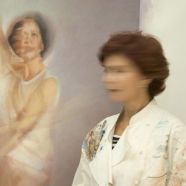Annette Polan
I grew up in West Virginia until I left for high school in Bryn Mawr, Pennsylvania. I graduated from Hollins College–now Hollins University–an all-female liberal arts school tucked into the Southwest Virginia Mountains. After four years–the most significant one was my junior year in Paris–of intense intellectual debates and wild weekend parties at UVA or Princeton, I stepped into the real world. The Beatles, birth control, Vietnam, and political assignations tempered the protective bubble around my classmates and me, but I was little aware of what was out there or how to navigate it. Knowing I probably couldn’t get a job and I wasn’t ready to marry, graduate school seemed the best available option. I selected visual arts over art history to study after graduation almost on a whim. Equally serendipitously, I ended up at the Corcoran College of Art in Washington, DC, where, a few years later, I stumbled into a feminist conference on Women in the Visual Arts. That changed my life.
Fifty years later and I’m still amazed that I’ve had a successful career doing work that I loved. I have been able to care for my children and myself and contribute to society through my work. To say that my life continues to exceed my dreams is an understatement. My successes have been a combination of good luck, a little talent, and a fearless attitude. I lucked into a teaching opportunity at the Corcoran before my first child was born. I honed my instincts for survival in the macho environment of the Corcoran where I was one of only three women on the faculty.
Driven by a passion for portraiture, I began to carve out a niche in figuration when the art world was all about abstract painting. Bucking current market trends could have been seen as either stupid or brilliant. In reality it was neither. As I still hadn’t developed a career mentality as an emerging artist, I naively thought I could make art without worrying about necessities of life. Fortunately my art has provided the better things of life.
Additionally, portraiture offered a flexible paradigm open to fresh approaches to the exploration of the “Nature of Self.” Throughout my career, I have used likeness to explore complex identities that lie behind appearances in myself and in others. I started making self-portraits as a young mother in the 1980s. After my mother died, I felt paralyzed by grief and unable to paint. In an effort to heal and get back to work, I reached out to something greater than my own pain and my own world. I turned to art when I found no words to express sadness and pain. The result was “Faces of the Fallen,” which brought Americans together to mourn and to celebrate lives lost in the wars in Afghanistan and Iraq.
Two hundred fifty American artists gave each of the first 1327 American statistics an identity and a face that will always be remembered by a family, by a school, by a community, and, in turn, by a country. The 1327 small portraits of every conceivable medium in “Faces of the Fallen” at the Women in Military Service of America Memorial in Arlington Cemetery spoke, “This is what we look like; this is who we are.” It was designed to give voice to the great American story. In turn, I found a new voice and a new reason to make art.
As I’ve aged, I’ve continued to investigate the Nature of Self through a series of intimate, introspective self-portraits, Fragile Strengths: A Covert Autobiography.
Ten Things I Can’t Do Without
- My children
- My grandchildren
- My dog Charlie
- Frequent-flyer upgrades
- HB pencils
- Pink Pearl erasers
- Photoshop
- iPhone/laptop
- The comics with my morning coffee
- My morning coffee







